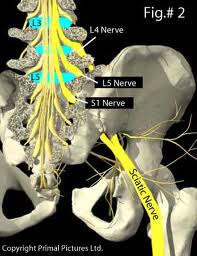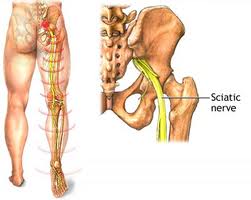Vancouver Sciatica Treatment
Our Registered Massage Therapist – Cole Majoros, RMT – is an expert in the field of low back pain and sciatica treatment.
Our downtown Vancouver Sciatica Treatment therapist can effectively treat sciatica, and help alleviate the symptoms of this very painful condition. He has techniques that are extremely helpful and can provide permanent relief, even for the most stubborn and persistent cases.

What is Sciatica?
The most common cause of sciatica is the compression of the nerve roots as they exit the low back, namely the L4, L5, and S1 nerve roots. The compression of these nerves is commonly caused by the degradation of the intervertebral discs; the discs between the vertebras. These discs often erode as we age, and are subject to injury or herniations. Lifting heavy objects, twisting, being in a car accident, or sometimes things as simple as a sneeze or a bowel movement can damage these discs.
Symptoms of Sciatica
Regardless of the type of Sciatica, you have the symptoms are the same. These symptoms include but are not limited to pain in the low back, buttocks and down the back of the leg. Numbness and tingling are also common symptoms and they follow the same pathway. Weakness can develop anywhere along this pathway because there is an interruption in the sciatic nerve transmission.
Sciatica Pain

Sciatica pain can be anywhere from mild to severe. It usually starts in the center of the low back or on top of the sacral bone, the triangular-shaped bone at the bottom of the spine. Often the pain begins to travel outwards into the gluteal area then progresses down the backside of the leg to the heel. Other times there is no back pain, just calf, heel, and foot pain.
Symptoms are highly variable depending on which nerve roots are being compressed, and how much compression there is. If the pain is local but rather intense, it’s probably a minor compression of the sciatic nerve.
Sciatica can also present with muscle weakness in the lower leg and foot. At times the foot may feel floppy or weak, or both. The hamstrings are often very tight and feel like they are going into an unrelenting spasm.
Anatomy of Sciatica
The sciatic nerve is the longest and largest nerve in your body. Five sets of paired nerve roots combine to create it, and it’s about the diameter of your middle finger. The sciatic nerve starts in your low back, which is called your lumbar spine. The nerve roots are at the L4 and L5 vertebrae (the ‘L’ means lumbar, and the numbers indicate the level of the vertebra where it is in your back). The sciatic nerve also travels through your pelvic region (sacrum).
In most people, the sciatic nerve runs under the Piriformis (bum) muscle, which moves your thigh side to side. From there, the sciatic nerve descends through the buttocks and the back of the thighs. Behind your knee, smaller nerves branch out from the sciatic nerve and travel down to your feet.
Causes of Sciatica
The most common cause of sciatica is the compression of the nerve roots as they exit the low back, namely the L4, L5, and S1 nerve roots. The compression of these nerves is commonly caused by the degradation of the intervertebral discs, the disc between the vertebras. These discs often erode as we age and are subject to injury or herniations. Lifting heavy objects, twisting, being in a car accident. Sometimes things as simple as a sneeze or a bowel movement can damage these discs.

Pseudo Sciatica is caused by a tightening of the Piriformis muscle on the Sciatic nerve. The nerve passes under the Piriformis muscle and in some cases, it passes right through the muscle tissue. Exercise, pregnancy, weight gain, and posture can create a tight Piriformis muscle.
True sciatica is caused by a variety of conditions: disk bulging or herniation, Degenerative Disk Disease (DDD), spinal stenosis and pregnancy.
How to Test for Sciatica
There are a variety of tests used to diagnose this condition. The first step is to go through a history of symptoms and activities with the client. Muscle and neurological tests are then done. An Xray, CT Scan or MRI might be needed, depending on the initial findings.
How to Treat Sciatica
Pseudo Sciatica is easily treated by massage therapy. Usually, in one treatment you will notice a dramatic improvement in your symptoms. Some home-care sciatica exercises are prescribed, and if you follow them, you shouldn’t have any more symptoms.
The first step in treating true sciatica is figuring out a way to take the pressure off of the nerve roots, and figuring out how to get the discs into proper alignment.
When the discs start to herniate, the jelly-like substance in the center of the discs (the nucleus pulposus) migrates backward, which bulges the backside of the disc (annulus fibrosis). So, in theory, if you could move the nucleus towards the center or even the front end of the disc, this would take the pressure off of the nerve roots.
Vancouver Therapists Treat Sciatica with a Unique Approach
Our Vancouver sciatica treatment therapists use a unique approach! We aim to reduces the pressure on the nerve roots, causing the leg pain to begin to resolve.
The pain usually starts to retreat toward the back or up the leg. This is called the centralization of symptoms. When the pain starts to centralize (sometimes locally) it can appear to be more intense. This is the brain’s interpretation of where the pain is coming from (the brain is tricking you).
Secondly, when there has been prolonged compression on a nerve (even slight pressure), the nerve begins to swell. As the nerve swells, the internal pressure in the nerve makes it difficult for blood to enter to have proper nerve function. The increased internal pressure creates tissue hypoxia, or tissue ischemia, which is a lack of oxygen and blood. All tissues in the body need oxygenated blood for proper function and health.

So the second question is how do you get the nerve to decrease its internal pressure to allow for proper blood flow?
Imagine if you will, that this long nerve is like a wet towel full of water. How do you get the water out of the towel? You simply wring out the towel. That is exactly what you can do to the nerve. By doing certain nerve stretching techniques you can wring out the nerve.
By wringing or stretching the nerve, the water molecules exit the nerve due to its’ elastic properties. The internal pressure decreases thus allowing the microcirculation to return, and the healing process to commence.
After applying these techniques along with structural alignment, we’ve found that they can be effective in treating mild to severe cases of sciatica.
You can book an appointment with our therapists by clicking on the online appointment button below, or you can call Electra Health at 604-685-4325 7 days a week from 8 am to 8 pm.
The body has an amazing ability to heal,
but sometimes needs a little help along the way.
Our downtown Vancouver treatment clinic has over 20 RMT’s on staff,
several of whom are professionally trained to treat sciatica pain.
For more information, or to book an appointment with one of our
Vancouver sciatica treatment therapists, call
604-685-4325
We’re open 8 am to 8 pm seven days a week
BACK to Massage Therapy Clinic



